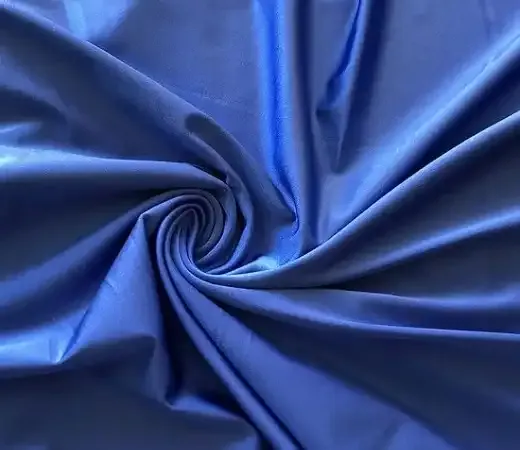Introduction
Lycra fabric, spandex, or elastane, has revolutionized the textile industry with its exceptional stretch and recovery properties. This innovative synthetic fiber has become a staple in various applications, from sportswear and swimwear to everyday clothing. With its remarkable elasticity and comfort, Lycra fabric provides a perfect fit, enhances mobility, and ensures garment durability. This article will explore the origins, manufacturing process, properties, and wide-ranging applications of Lycra fabric, its advantages, disadvantages, care instructions, and the latest technological advancements. Additionally, we will delve into the sustainability aspects and environmental impact associated with this versatile fabric. Whether you are a fashion enthusiast, designer, or simply curious about the science behind stretchable fabrics, this comprehensive guide will provide valuable insights into the world of Lycra fabric.
What is Lycra fabric?
Lycra fabric, spandex or elastane, is a synthetic textile made from polyurethane fibers. It is renowned for its exceptional stretch and recovery properties, making it a popular choice in various industries, particularly fashion and sportswear.
History and origin of Lycra fabric
Lycra fabric was invented in the late 1950s by chemist Joseph C. Shivers Jr. at the DuPont laboratories in the United States. Originally developed as a replacement for rubber, Lycra quickly gained popularity due to its superior elasticity and durability. Since then, it has become an essential ingredient in countless clothing items, revolutionizing how we dress and move.
Properties and characteristics of Lycra fabric
i. Stretch and elasticity
One of the critical features of Lycra fabric is its exceptional stretchiness. It can comfortably stretch up to seven times its original length, allowing for freedom of movement and a snug fit. Whether you're doing yoga poses or dancing the night away, Lycra fabric moves with you, providing comfort and flexibility.
ii. Recovery and durability
In addition to its fantastic stretch, Lycra fabric boasts remarkable recovery. After being stretched, it returns to its original shape, ensuring a garment maintains its fit over time. This quality helps prevent sagging or bagging, making Lycra garments long-lasting and resistant to wear and tear.
iii. Breathability and moisture-wicking
Contrary to popular belief, Lycra fabric does not suffocate or sweat. It is designed to be breathable, allowing air to circulate through the fabric, keeping you cool and comfortable. Moreover, many Lycra fabrics incorporate moisture-wicking properties that draw sweat away from the body, ensuring you stay dry and fresh during intense workouts or hot summer days.
The manufacturing process of Lycra fabric
i. Production of Lycra fibers
Lycra fibers are created through a complex chemical process involving spinning and reacting various polymers. The result is a fine, elastic fiber that can be blended with other fabrics or used to create Lycra fabric.
ii. Incorporation of Lycra in fabric production
The Lycra fibers are combined with other fibers such as cotton, nylon, or polyester to produce Lycra fabric. This blending process allows manufacturers to create fabrics with specific stretch and recovery qualities, catering to different needs and applications.
iii. Finishing processes for Lycra fabric
After the fabric is woven or knitted, it undergoes finishing processes such as dyeing, printing, and unique treatments to enhance its appearance, performance, and durability. These finishing touches ensure that the final product meets the desired standards and fulfills the unique requirements of each application.
Applications of Lycra fabric in the fashion industry
i. Lycra in sportswear and activewear
Lycra fabric has revolutionized the world of sportswear and activewear. From yoga pants to compression shirts, Lycra's stretch and recovery properties provide the ideal fit and support for various physical activities. It allows athletes and fitness enthusiasts to move freely, offering muscle compression and improved performance.
ii. Lycra in swimwear
When it comes to swimwear, Lycra fabric is the go-to choice. Its ability to stretch and recover ensures a comfortable and flattering fit, while its resistance to chlorine and salt water makes it perfect for beach vacations and pool parties. Lycra fabric keeps swimwear in shape, providing confidence and style whether you're swimming laps or sunbathing.
iii. Lycra in casual and formal wear
Lycra fabric has also found its way into everyday fashion. It is commonly used in casual wear like leggings, t-shirts, and jeans, providing comfort and ease of movement in everyday activities. Additionally, Lycra blends are often incorporated into formal wear such as dresses and suits, offering a touch of stretch to ensure a sophisticated and comfortable fit for those special occasions.
So, whether you're hitting the gym, diving into the pool, or simply relaxing in style, Lycra fabric enhances your experience with stretch, recovery, and breathability. It's a true game-changer in the world of textiles, making our clothes more comfortable, versatile, and fashionable.
Advantages and Disadvantages of Using Lycra Fabric
i. Benefits of Lycra Fabric
Lycra fabric, also known as spandex or elastane, is like the superhero of textiles. It offers many benefits, making it an ideal choice for clothing and other applications.
First and foremost, Lycra fabric provides excellent stretch and recovery properties. This means that your clothes will retain their shape and fit snugly against your body, even after hours of wear. No more saggy bottoms or baggy knees!
Lycra fabric is also highly comfortable to wear. Its exceptional flexibility allows for a wide range of movement without feeling restricted. Whether you're doing yoga, dancing, or simply lounging around, Lycra fabric will feel like a second skin.
Additionally, Lycra fabric is highly resistant to wrinkles. Say goodbye to ironing or worrying about creased clothes when you pull them out of your suitcase. Lycra fabric has your back, or rather, your wardrobe, covered.
ii. Limitations and Considerations
Despite its many benefits, Lycra fabric does have a few limitations worth noting. One of the main concerns is its vulnerability to heat. High temperatures can cause the fabric to lose its elasticity, so avoiding exposing Lycra garments to excessive heat during washing or drying is essential.
Another consideration is that Lycra fabric retains odors more than other materials. This can be a downer if you plan to wear your Lycra workout pants for multiple gym sessions before washing them. If you're prone to sweating like a marathon runner, washing your Lycra garments more frequently may be best to keep them smelling fresh.
Overall, the advantages of Lycra fabric far outweigh its limitations. Just remember to handle it with care and give it the love and attention it deserves.
Care and Maintenance of Lycra Fabric
i. Washing and Drying Recommendations
Taking care of your Lycra garments is essential to ensure they stay in tip-top shape for as long as possible. Here are a few tips to help you out:
When washing Lycra fabric, opt for a gentle cycle on your washing machine with cold water. Harsh detergents can damage the elasticity, so choose a mild one that won't strip away its magical stretchiness.
As tempting as it may be, avoid using a dryer to dry your Lycra garments. Instead, gently pat them dry with a towel and lay them flat to air dry. A little extra patience will go a long way in preserving the longevity of your Lycra apparel.
ii. Storing and Handling Lycra Fabric
To store your Lycra garments, avoid hanging them on hangers, as this can cause them to stretch out of shape. Fold them neatly, place them in a drawer, or stack them on a shelf.
When it comes to handling Lycra fabric, be gentle. Avoid pulling or tugging excessively, as this can strain the fibers and lead to loss of elasticity over time. Treat your Lycra garments carefully; they will reward you with a long-lasting stretchy embrace.
Innovations and Developments in Lycra Fabric Technology
i. Enhanced Stretch and Recovery Technologies
Innovation never sleeps, and the same goes for Lycra fabric technology. Manufacturers are constantly striving to improve the stretch and recovery properties of Lycra fabric, making it even more comfortable and durable.
New fiber spinning techniques and fabric construction advancements allow for enhanced stretch capabilities while maintaining excellent recovery. This means you can move freely without worrying about your clothes losing shape.
ii. New Fabric Constructions and Finishes
Beyond stretch and recovery, technology has paved the way for exciting fabric constructions and finishes in Lycra. From moisture-wicking properties for athletic wear to UV protection for outdoor enthusiasts, there's a Lycra fabric for every need.
Innovative fabric constructions and finishes help enhance the performance and functionality of Lycra garments, making them more versatile and tailored to specific activities or environments. So, whether you're hitting the gym, swimming, or enjoying a sunny picnic, a Lycra fabric has covered you.
Sustainability and Environmental Impact of Lycra Fabric
i. Lycra's Role in Sustainable Fashion
As sustainability becomes increasingly important in the fashion industry, you might wonder about Lycra fabric's eco-credentials. The good news is that Lycra fiber can be recycled and incorporated into new products, reducing waste and minimizing environmental impact.
Furthermore, the durability and longevity of Lycra fabric contribute to sustainable fashion practices by reducing the need for frequent replacements. Clothes made with Lycra are built to last, allowing you to enjoy them for an extended period.
ii. Environmental Considerations in Lycra Production
While Lycra fabric has its sustainability benefits, it's worth noting that its production does have some environmental considerations. The manufacturing process of Lycra requires energy and resources, and certain chemicals are involved.
However, efforts are being made within the industry to mitigate these impacts. Manufacturers are exploring more sustainable production methods, such as using recycled water and minimizing chemical usage. As technology continues to evolve, we can expect further improvements in the environmental footprint of Lycra fabric production.
Conclusion
Lycra fabric offers many advantages, making it a top choice for stretchy and comfortable clothing. With proper care, Lycra garments can last long, and technological innovations continue to improve their performance and sustainability. So embrace the stretchy goodness of Lycra, knowing that you're both fashionable and eco-conscious.In conclusion, Lycra fabric has undeniably transformed the fashion industry by offering unparalleled stretch, comfort, and versatility. Its unique properties have made it an essential component in numerous garments, ensuring a perfect fit and enhanced performance. As advancements continue in Lycra fabric technology, we expect even more innovative applications and improved sustainability measures. Whether you're an athlete seeking optimal sportswear or a fashion enthusiast looking for comfortable yet stylish clothing, Lycra fabric is sure to impress. So, embrace the stretch and endless possibilities that Lycra fabric brings to the fashion world.
Some Special Question
1. Is Lycra fabric only used in athletic wear?
Lycra fabric is commonly associated with sportswear and activewear due to its stretch and flexibility. However, its applications extend far beyond athletic wear. Lycra fabric is also widely used in swimwear, lingerie, jeans, leggings, dresses, and formal wear. Its ability to provide comfort, shape retention, and a flattering fit makes it a popular choice across various fashion categories.
2. How should I care for Lycra fabric?
Caring for Lycra fabric is relatively simple. It is recommended to wash Lycra garments in cold water with a gentle cycle to prevent damage to the fibers. Avoid using bleach or harsh detergents. Additionally, it is best to air dry or use a low-heat setting when machine-drying Lycra fabric to preserve its elasticity. Proper care ensures that your Lycra garments retain their stretch and longevity.
3. What are the sustainability aspects of Lycra fabric?
Lycra fabric manufacturers are increasingly focusing on sustainability and environmental impact. Many brands are now incorporating recycled or eco-friendly materials in producing Lycra fibers. Additionally, advancements in Lycra technology aim to reduce energy consumption during manufacturing processes. However, it is essential to note that the overall sustainability of a garment also depends on other factors, such as production methods and end-of-life disposal practices.
4. Can Lycra fabric cause allergic reactions?
While allergic reactions to Lycra fabric are rare, some individuals may be sensitive to the synthetic fibers or the chemicals used during manufacturing. If you have known sensitivities or allergies, it is advisable to test a small patch of fabric on your skin before wearing Lycra garments for an extended period. If any irritation occurs, avoid wearing Lycra fabric or choose garments with a lining or barrier fabric between the skin and Lycra.












0 Comments